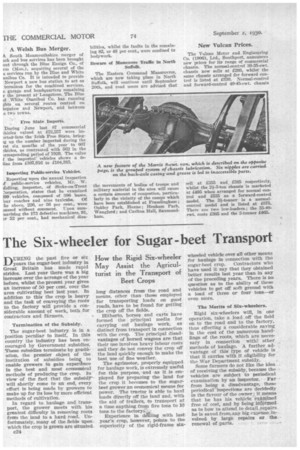The Six-wheeler for Sugar-beet Transport
Page 46

If you've noticed an error in this article please click here to report it so we can fix it.
How the Rigid Six-wheeler May Assist the Agriculturist in the Transport of Beet Crops
DURING the past five or six years the sugar-beet industry in Great Britain has made rapid strides. Last year there was a big increase over the acreage of the year before, whilst the present year gives an increase of 50 per cent, over the area cultivating beet last year. In addition to this the crop is heavy and the task of conveying the roots to the factory will provide a considerable amount of work, both far contractors and farmers.
Termination of the Subsidy.
The sugar-beet industry is in a position peculiar to itself. In this country the industry has been encouraged by Government subsidies. These subsidies terminate by graduation, the premier object of the institution of subsidies being to enable growers to gain experitnee in the best and most economical methods of producing the crop. In view -of the fact that the subsidr will shortly come to an end, every effort is being made by growers to make up for its loss by more efficient methods of cultivation.
In regard to haulage and transport, the grower meets with his greatest difficulty in removing roots from the land to a hard road. Unfortunately, many of the fields upon which the crop is grown are situated.
c24
long distances from the road anti means. other than those employed for transporting loads on good roads, have to be fbund for getting the crop off the fields.
Hitherto, horses and carts have formed the principal media for carrying out haulage work, as distinct from transport in connection with the crop. The principal disadvantages of horsed wagons are that their use involves heavy labour costs and they do not convey the crop off the land quickly enough to make the best use ,of fine weather.
The agrimotor, properly equipped for haulage work, is extremely useful for this purpose, and as it is employed for preparing the land for the crop it becomes to the sugarbeet grower an economical means for power. The tractor is able to haul loads directly off the land and, with the aid of trailers, to transport at a time anything from five tons to 10 tons to the factoryikii.. Experience in dealing with last year's crop, however, points to tbe superiority of the rigid-frame six wheeled vehicle over all other means for haulage in connection with the sugar-beet crop. Contractors who have used it say that they obtained better results last year than in. any of the preceding years. There is no question as to the ability of these vehicles to get off softground with
a load of three or four tons or even more.
The Merits of Six-wheelers.
Rigid six-wheelers will, in one operation, take a load off the field on to the road and to the factory, thus effecting a considerable saving in the cost of the numerous handlings of the roots, which are necessary in connection witW: other, r methods of haulage. A further advantage of this type of vehicle is that it carries with it eligibility for the War Department subsidy.
Some farmers do not like the idea of receiving the subsidy, because the vehicles are subject to periodical examination by an inspector. Far from being a disadvantage, these periodical inspections are decidedly in the favour of the owner ; it Means that he has hi vehicle exaMined free of cost, and by being inPrtned . as to haw to. attend to detnit .repain he is saved from. any hig.expense valved by large repairs or the renewal of parts.












































































































